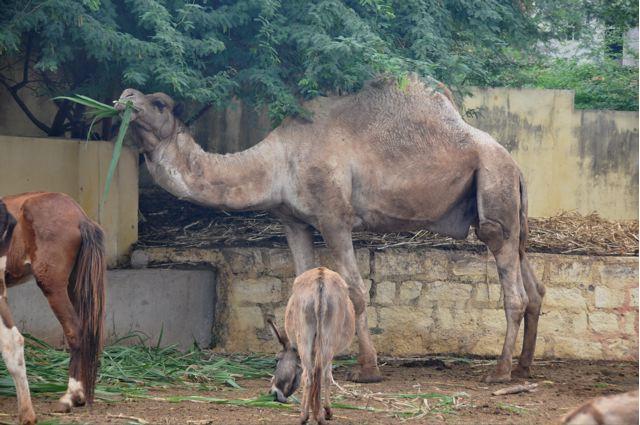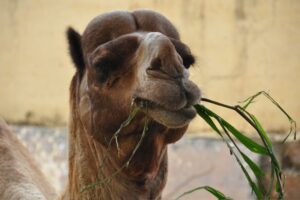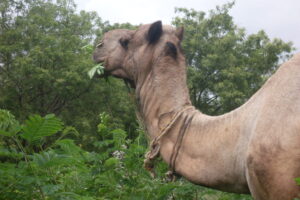What it Takes to Rescue a Camel!
Narendra remembers…
On Wednesday, 14 February 2007, we got a call about a camel being exhibited for the past 3 days by a person named Patan Hyder Vali, on the streets of Kadiri in Andhra Pradesh (about 50 km from our Karuna Society near to Puttaparthi). The camel had a banner on its body advertising the date of its slaughter and the cost per kg of its meat, and he was being broadcast live on Gemini TV. People saw the live camel and booked its meat in advance by paying and getting a token.
Narendra Reddy, Karuna Society’s Secretary and G. Manjunath the Treasurer, immediately went to the spot along with a Police team to investigate the matter. On arrival at the scene, it was discovered that the Camel was about to be slaughtered in a matter of a few seconds.
The slaughter was stopped and the owner and his accomplices were taken to the Police Station. This was only the beginning!
The actual troubles started once the Camel was rescued. Religion was made the centre of attention and all problems revolved around its traditions. Most of the VIPs involved in this case included local politicians who belonged to the same faith, which meant that Karuna had very little or no support to rescue this Camel.
The police were reluctant to book a case as there is no law in South India prohibiting the slaughter of a camel. That is only because camels do not belong to the South and there are no certified special slaughterhouses, as is compulsory in North India. This means that the slaughter of camels in the South is illegal by default.
We were almost ready to give up, but not without a fight! That’s when we decided to make the next move. Mrs. Maneka Gandhi (an influential Indian politician, animal rights activist and environmentalist) was contacted, and while we waited for a miracle, we were able to convince the Police to keep the camel alive overnight.
The next morning, in a not-so-surprising turn of events (no doubt due to the intervention of Maneka Gandhi!), the cops were all over the place trying to help us, Karuna Society, to ‘rescue the camel’.
It was then official! The camel was rescued!!
The next challenge was to bring the camel to our facility. The beautiful giant did not trust us enough to get into the truck without his owner. Obviously, we did not give up. Our Telugu-speaking rescuers had a trick up their sleeves and managed to order the camel, Raja, in his native language of Hindi which he understood, and got him to sit in the truck!
This was only the beginning of a long and painful legal fight to give Raja his rights!
The accused approached the court and tried to get the camel back. He claimed that he owned the camel and therefore he had the right to do with it as he pleased. He claimed that he will keep the camel as a pet and only use it for tourism purposes.
This was opposed strongly by our lawyers and we fought head on! We hired one of the best lawyers, Mr Prabhakar Reddy and a case was filed (C.C. No. 171 of 2009) at the ADDL. JUDL. I Class Magistrate Court in Kadiri.
The case was fought for 2.5 years and we finally claimed victory and the freedom of Raja, who by now, was truly the ‘King’ of our hearts and shelter.
Unfortunately, it wasn’t over yet. The accused and former owner approached a higher court, the Court of the Sessions Divisions of Anantapur at Anantapur (C.C. No. 110 of 2010).
Raja was now legally our property, and we refused to give up on him, which made us stronger. We approached the High Court of Judicature of Andhra Pradesh in Hyderabad (C.C. No. 2442 of 2011).
We fought on the grounds that:
- There was no evidence of ownership of the camel.
- There was no legal slaughter provision for the camel in South India; therefore, the slaughter was illegal and cruel to the animal.
- The camel was illegally transported from North India to South India on foot over a period of 3 months. This caused severe injuries to the feet of the camel and also caused him to be dehydrated and malnourished. This is a clear violation of the ‘Prevention of Cruelty to Animals Act, 1960’.
- It was also illegal for animals to be transported from one state to another without legal permission.
- The camel was exhibited for sale of its meat. This was again a violation of the ‘Prevention of Cruelty to Animals Act, 1960’.
After another one year of fighting, we finally won the case! The matter was officially closed. Raja was finally FREE to live his life grazing and spending time doing what matters to him most – being safe and at peace!
Raja’s life at the Shelter (since 2007)
Raja, meaning ‘The King’, was true to his name: big in size and in heart!
It was no easy task pleasing the King – he had to have his own royal crew! Rightly, a personal assistant was hired for him, who fed and groomed his Royal Highness. Raja was pleased with the services offered to him.
The only thing still stuck to Raja from his past was his ‘nose ring’. Before we could get a surgeon to remove the ring, Raja decided he could handle a ‘do-it-yourself’ procedure and ripped the ring right out of his nose. What followed was NOT approved by Raja: a week of antibiotics and dressing! He was fine eventually.
There was no leash or pain controlling him anymore and Raja could finally roam free and sometimes go out grazing with the cattle…or so we thought. Soon we found wounds and bruises on his feet. The rocky soil in this arid area contains many small stones and pebbles and even a short walk in this area proved unsuitable for him. We can only imagine the pain and agony he had to endure during his 3 month long journey from Rajasthan in North India to Kadiri in the South!!
In the best interest of Raja, we had to confine him within the premises of the cattle shelter which was covered with smooth and soft soil which would help him heal and keep him pain-free.
He now walks freely in a 1-acre compound and sleeps peacefully in a specially designed shed. He enjoys special treats from not only his keeper and the staff, but from many visitors and supporters too.
Puttaparthi is generally a drought prone area; however, recently we have had heavy rains and because of this there are now plenty of green trees growing around the shelter. The area is also covered in green grass, which means that Raja now has soft ground to walk on. This is a good opportunity for Raja to explore the nearby territory – he is now allowed to go out to graze for a few hours a day.
It is very important to note that he is very comfortable with the cattle and has made quite a few friends here!


